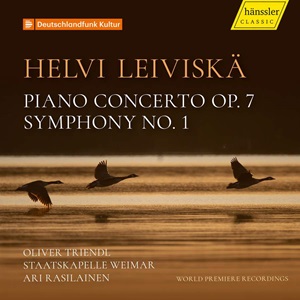
Helvi Leiviskä (1902-1982)
Piano Concerto in D minor, Op 7 (1935)
Symphony No 1 (1947)
Oliver Triendl (piano), Staatskapelle Weimar/Ari Rasilainen
rec. 2023, Deutschlandradio, Köln
Hänssler Classic HC23050 [45+40]
To me, there are little-known composers and unknown composers. The Finnish symphonist Helvi Leiviskä, a student of Madetoja and Melartin, fits into the second group quite comfortably. None of her major works were published in her lifetime. The booklet note gives little biographical information, but there are many interesting facts in an article in The Finnish Music Quarterly, which also discusses ongoing attempts to edit, publicise and perform her works. Very briefly: she started as a music teacher, spent most of her life as librarian at The Sibelius Academy, and performed as a concert pianist. She wrote this piano concerto, three symphonies plus a Sinfonia Brevis, as well as cantatas, piano and chamber music.
The article says that one can detect the influence of Madetoja and Melartin in Leiviskä’s works. I have some of their works, but do not know their styles well enough to make that judgement.
The piano concerto has had to be reconstructed from orchestral parts and a piano reduction. The latter contains several cuts and modifications by the original soloist, so it does not match the orchestral information. This recording presents the original piano part. The 45-minute concerto has three movements of more-or-less equal timings. The first movement begins very slowly in the depths of the orchestra, and then the piano joins in from its low registers. I immediately thought of Ravel’s Left-Hand Concerto, but the resemblance soon ends. To be frank, I find the movement sprawling and formless. Its themes are not in the least bit memorable.
The other movements present the themes much better. The second Vivace movement begins with a glockenspiel-like passage. That leads into the jaunty main motif, repeatedly interspersed with an orchestral interlude derived from the first movement. After a brief silence, the music moves towards its culmination, which is not Vivace at all. It is rather slow and solemn as it leads into the third movement.
Unusually, the last movement opens with a fugue that uses a Poco tranquilo theme from the first movement as its subject, and it culminates in a stately ultra-romantic passage halfway through. There follows a calm interlude in which the piano and orchestra murmur gently, utilising fragments of the preceding themes. A solo violin becomes prominent, followed by a cadenza-like passage. That leads into another extended, passionate section in which the orchestra and soloist compete in a most satisfactory manner. For me, this is easily the most enjoyable part of the concerto. There is no doubt that it is being brought to a crowd-pleasing culmination.
To summarise, the concerto took a long time to make much of an effect, and the first movement still has not – it may be too long for its content.
The four-movement, 40-minute symphony sits on the second disc. Leiviskä had to pay for its first performance by the Finnish Radio Orchestra in 1948. Broadly speaking, I find it immediately more impactful and attractive than the piano concerto. The first movement opens with a quite attractive woodwind ‘birdsong’, soon supplemented by the strings and then the rest of the orchestra. It is all very impressionistic. There appears a waltz theme, then interrupted by the movement’s main motif, which also appears later in the work. Things rise to a brief climax, suddenly broken off. The orchestra plays around with the main theme and things get quite stormy, threatening even. That leads to a passionate culmination in the last couple of minutes of the movement. I enjoyed the music in a mild sort of way, but at the same time, wished that the themes were more memorable.
At the beginning of the Andante sostenuto second movement, the bass clarinet plays a gloomy, rather unattractive theme derived from the principal theme of the first movement. At 12:40, this movement is the longest. By the four-minute mark, it has risen to a somewhat anguished climax which fades away and is superseded by the birdsong. The music calms and becomes far more melodically lyrical, with a second climax, and eventually tails off into the unattractive bass-clarinet theme.
The third movement is a five-minute scherzo. It uses the birdsong motif and the waltz to evolve into a huge crescendo leading into the last movement. In it, the composer unifies the whole work by generating another dance theme based on the waltz, and more experiments with the birdsong and preceding themes. The coda is also derived from the main theme of the second movement.
With the best will in the world in support of the resuscitation of neglected tonal 20th-Century music, I really doubt that I will want to spend much time with either of these works. I do not know if, as she grew older, the composer developed her melodic armoury to a greater degree than is on display here. According to online information, her later works relied on neo-classicism. Fennica Gehrman, a Finnish music publishing company, notes on its website: “Her Late Romantic musical expression evolved during her composing career. The style could also be described as moderate modernism influenced by late Romanticism, Symbolism, Expressionism, Existentialism and Neo-Classicism.” A fair number of -isms, then, but none for ‘melodically-memorableism’.
The recording is excellent, as are the performances of music which must have been new to the orchestra.
The booklet, in German and English, includes a few examples from the score. The layout of the text in relation to the score details is rather peculiar, interrupting reading somewhat. As noted, biographical details are sparse, and the description of the music is rather technical. There are black-and-white photos and biographies of the performers. The music is just a few minutes too long to fit on one CD, but there is no clear evidence of a two-for-one deal.
Jim Westhead
Help us financially by purchasing from



















